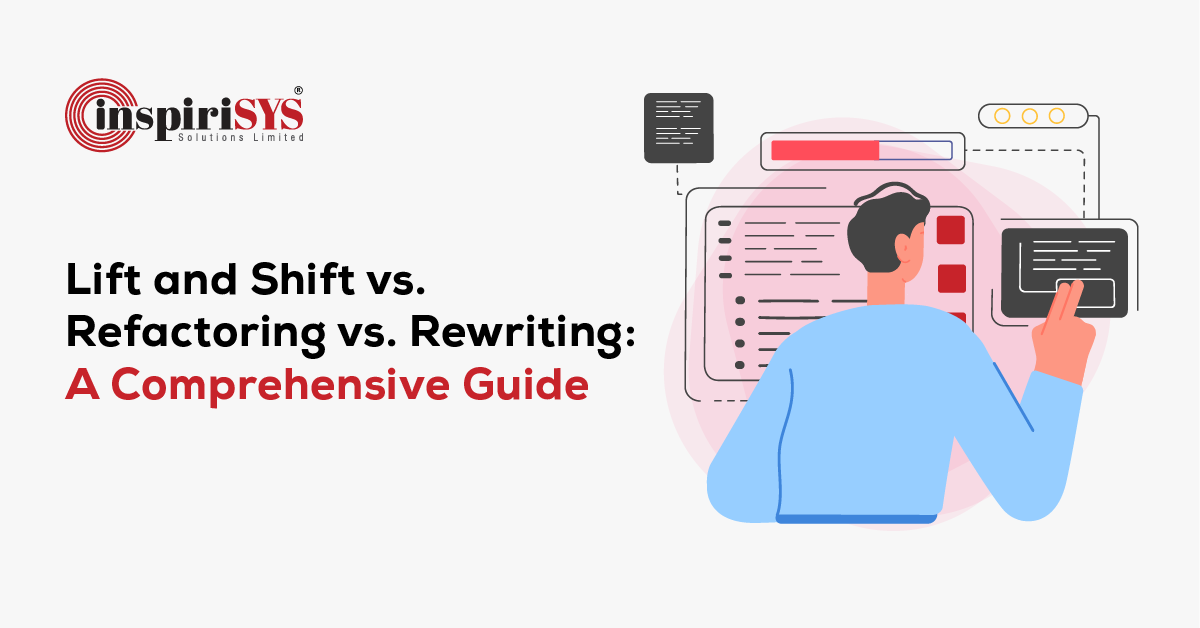Technology's rapid development has created a crossroads for businesses looking to modernize their systems. To achieve benefits like cost savings and scalability, most companies are migrating their legacy systems to the cloud.
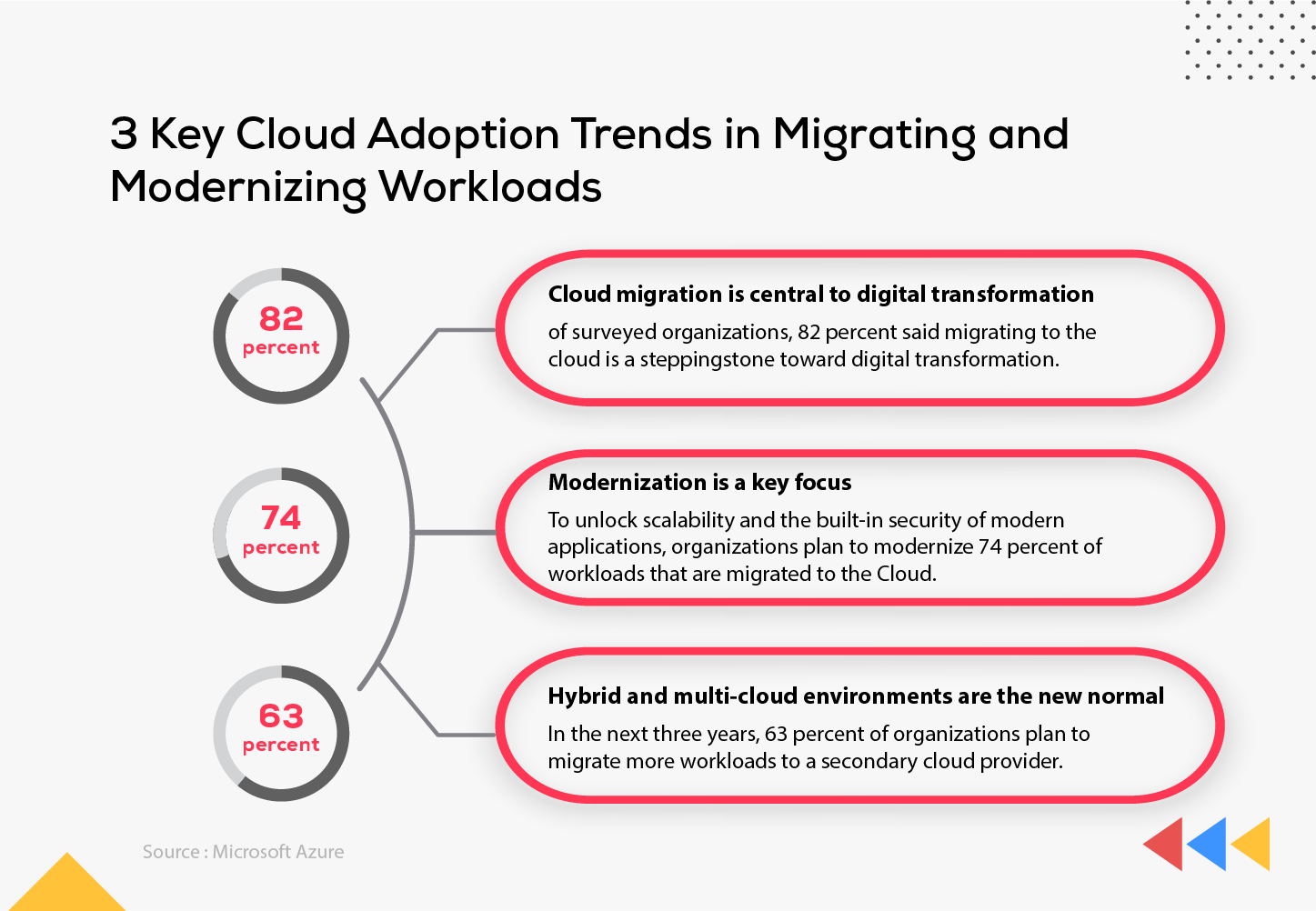
According to a Microsoft Global Survey, 82% of organizations stated that cloud migration is a stepping stone towards digital transformation.
Furthermore, organizations intend to modernize 74% of workloads moved to the cloud to leverage the enhanced security embedded in modern applications.
Organizations expect to move more workloads to a secondary cloud provider in the next three years, with 63% anticipating this change.
To stay competitive as technology advances, a new strategy that enhances effectiveness, application scalability, and overall performance must be implemented. Here is where, ‘lift and shift’, ‘refactoring’, and ‘rewriting’ techniques are employed.
Let us explore these techniques.
Lift and Shift Migration
As part of the lift and shift cloud migration strategy, apps are deactivated before being uploaded to a new cloud. Once the cloud storage is set up for future use, databases and on-premises application for the selected data are migrated.
There are no significant changes made in applications, processes, or databases. This approach is well-liked by organizations that want to migrate a portion of their IT systems to the cloud. Also, it functions better for short migration deadlines.
Factors to Consider before Selecting Lift and Shift Migration
Before deciding on the lift and shift migration, organizations should carefully consider whether it will meet their business needs. Lift and shift migration is best served by commercial applications with clearly defined components.
Secondly, make a detailed comparison of the costs of both on-premises and cloud-based solutions. This includes both one-time investment costs and ongoing expenses for things like power and bandwidth.
Advantages of Lift and Shift Migration
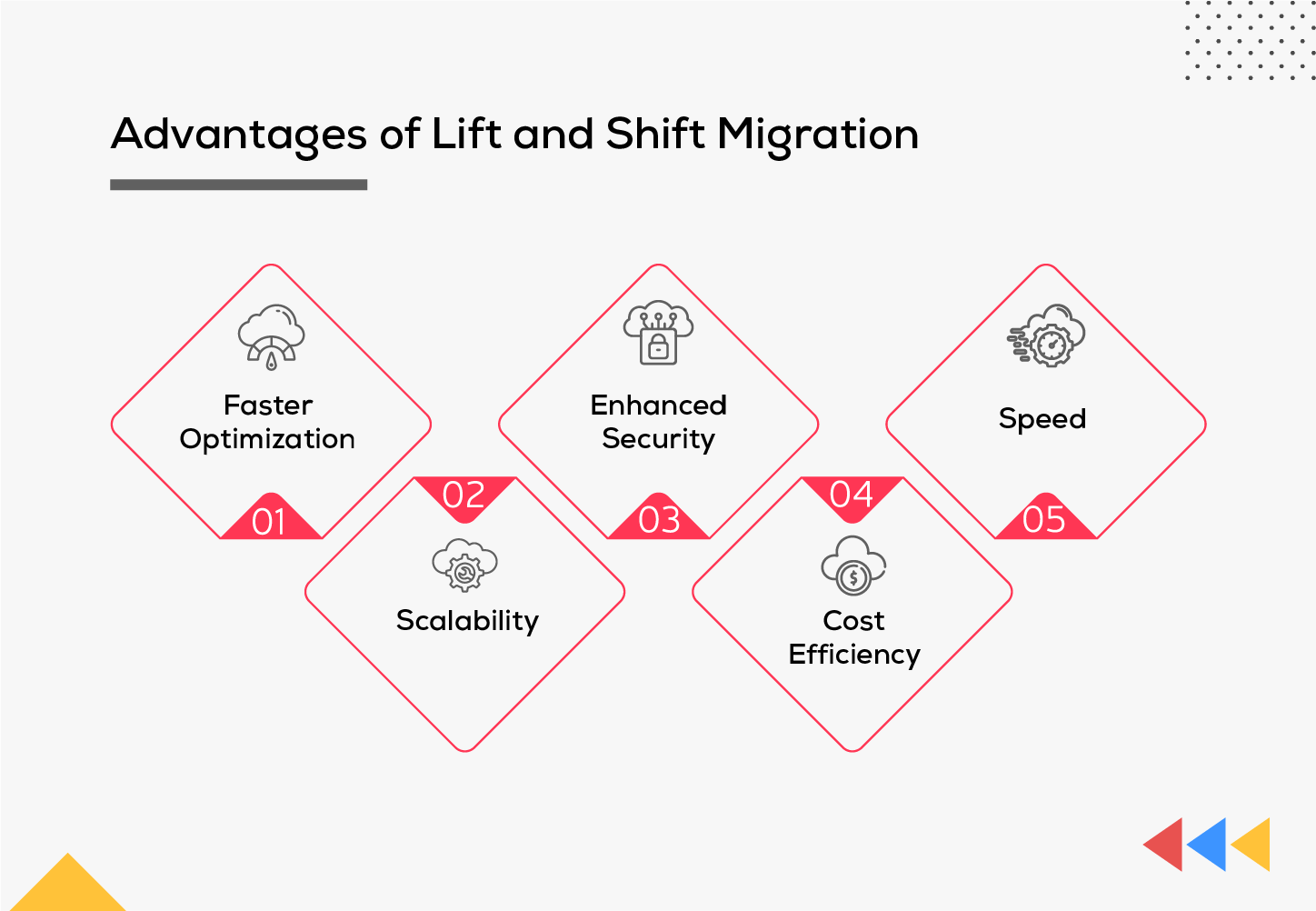
Let's list the advantages of Lift and Shift in the context of cloud migration.
Faster Optimization
The lift and shift migration technique is considered the fastest way to move applications to the cloud. The need for redesign or modification can be reduced by using the cloud platform to quickly migrate an organization’s current workload and applications.
Enhanced Security
Cybersecurity is a common problem that gives businesses nightmares. However, by utilizing the lift and shift approach you can migrate to the cloud without being concerned about security issues. By employing this technique, you can get multifactor authentication while safeguarding your current infrastructure. Updates and backups make it easy to enhance the cloud.
Speed
A lift and shift operation is the quickest way to fill up public cloud resources. There is no need to allocate a specific time for code revision and optimization separately. Additionally, you have the choice to modify the app and upload it to the cloud.
Scalability
Lift and shift migration doesn’t require major changes to the prevailing application infrastructure. Moreover, overprovisioning of the hardware is not necessary to handle peak traffic periods.
Cost-efficiency
An application that can automatically scale up and down resources in response to demand may also profit from the elasticity of the cloud. Cost optimization can be achieved by using the necessary resources if the cloud is more elastic and your application can take advantage of it.
Disadvantages of Lift and Shift Migration
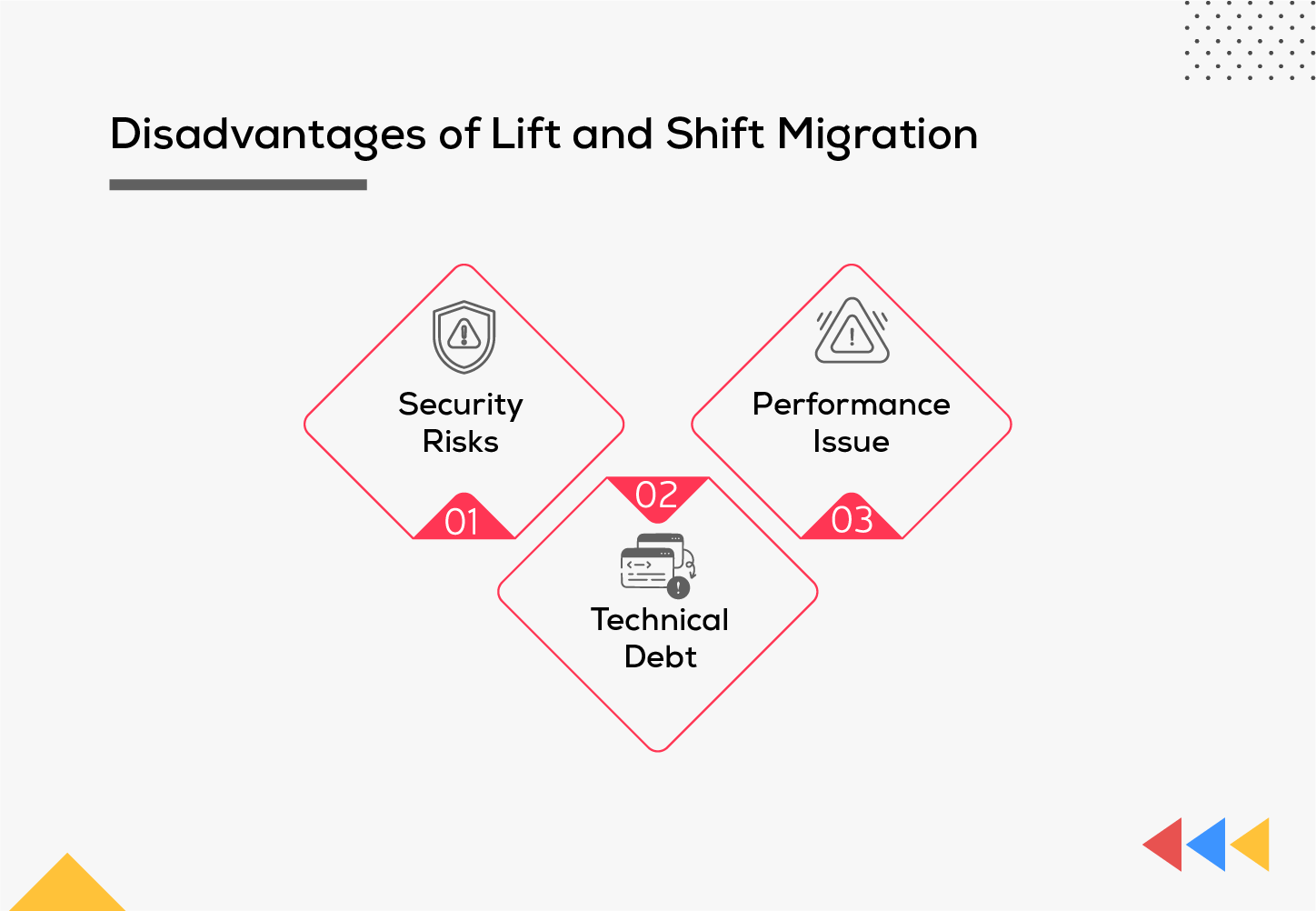
One of the biggest disadvantages is that not all the legacy apps were made to run on virtual machines. Apart from that, some of the disadvantages include:
Security Risks
Cloud-based security risks cannot be handled if the apps are built on-premises. Therefore, a new set of assessment tools is required to migrate threats.
Technical Debt
To stay compatible, the legacy application needs to undergo code maintenance. In the long term, the maintenance charge is high, thereby increasing technical debt.
Performance Issue
This method involves relocating the application to an entirely different environment, potentially resulting in performance issues for legacy projects and on-premises systems post-migration. Despite these challenges, it's worth noting that moving current applications to the cloud allows you to leverage cloud infrastructure without requiring immediate and significant code changes.
Refactoring
In the modern digital era, cloud migration has become an essential part of business operations. Businesses are moving their data and applications to the cloud to gain access to scalability and improved application performance. However, the process of moving applications to the cloud is more difficult. This often entails significant maintenance of current infrastructure and applications to ensure optimal performance and functionality. This is where refactoring plays its role.
The non-functional features and internal organization of software source code are improved through the process of code refactoring. The ultimate goal of refactoring is to make small changes without changing the code’s behaviour and improve internal code. Refactoring simplifies code and enhances its readability while helping software developers identify vulnerabilities and bugs.
Now, let's explore the objective of refactoring, aiming to enhance the code and achieve the following benefits.
- Improved reusability by enhancing efficiency and readability.
- Efficient handling of complexities and dependencies.
- Cleaner code for easy reading and comprehension.
- Simplified bug and vulnerability detection for software developers.
When to Use Refactoring
Now that we have learned about refactoring, it is important to identify when to choose this approach.
Is your company in need of features, scale or performance? In this case, refactoring is the best choice. Further, utilizing cloud features offer distinct advantages that can be challenging to obtain in the current non-clod environment.
Secondly, refactoring is the most efficient cloud model particularly due to its cloud-native application, leading to reduced costs and improvements in security, operations, and responsiveness. Finally, organizations seeking code restructuring and improved business continuity, migrating through refactoring stands as a perfect choice.
Benefits of Refactoring
Here are some of the key benefits of refactoring:
- The goal of refactoring is to simplify and make the code readable by removing unnecessary variables, longer classes, redundant code, unnecessary loops, and longer methods.
- Refactoring makes it easy to spot vulnerabilities and make changes. Further, it enables a deeper understanding of the code.
- The primary focus is on functionality. The original project won’t lose its focus by keeping the code’s functionality intact.
- It’s much easier to update and improve the code. Developers can introduce fresh features to users while reducing the support budget as the maintenance time is low.
- Refactoring code is a way to enhance software maintainability, making it easier to modify and understand. This involves improving naming conventions, enhancing module cohesion, and simplifying complexities, ultimately resulting in more readable code.
Drawbacks of Refactoring
Though refactoring offers a wide range of advantages, it also has major drawbacks.
Time-Consuming
Generally, code refactoring is time-consuming. The process of refactoring can even take months, depending on the complexity and size of your app. In addition to completely rewriting the design of the existing code, you also need to budget time for testing the modified code and performing debugging procedures.
Refactoring Legacy Code is Expensive
This process can be quite expensive since code refactoring is time-consuming. Developers need to be compensated for their labour, and the financial aspect involved in refactoring tools should also be considered. These expenses cut into the budget that could otherwise be allocated towards business goals, innovative design decisions, and adding new features to the software.
To conclude, besides enhancing code quality, refactoring also positively impacts the development process, customer experience, and teamwork.
Rewriting
The process of application rewriting involves the gradual removal or reconstruction of the existing code base. By incorporating the most recent models, the rewriting process offers the chance to re-evaluate the application approach and testing procedures.
Through the process of rewriting, one can easily rectify various aspects, ranging from language usage to frameworks. Thus, it provides space to correct mistakes in the older version.
Benefits of Rewriting
Rewriting has a wide range of benefits that include:
Easy to Start
Rewriting becomes easier for developers as they are familiar with the application and are aware of areas that could be improved. They don't need permission from their superiors to initiate the rewriting process.
Stick to a Single Codebase
While rewriting, it is not necessary to establish two distinct codebases. Thus, maintenance costs are significantly decreased. Furthermore, it is easier to rewrite various modular software types.
Revitalizes App Design
Rewriting enables complete redesign of an application’s modules in addition to optimization.
Integration of the Latest Technology
Rewriting eliminates the tedious task of improvising the old code to meet the demand for new technologies and applications. It creates space for new technologies and modern platforms by enabling the migration of existing applications from one platform to another.
In conclusion, the decision of whether to engage in rewriting during code migration should be based on a thorough evaluation of the benefits, risks, alignment with organizational goals, and available resources.
Comparing the Application Migration Models
Now that we have looked at each modernization effort, let’s start comparing each model. To sum up, lift and shift refers to the process of transferring an entire application, from an on-premises or current environment to another. Whereas, refactoring is to make code changes without affecting the application’s external behaviour. On the other hand, rewriting is where a code is created without writing it from scratch.
Let’s now understand the differences between these approaches.
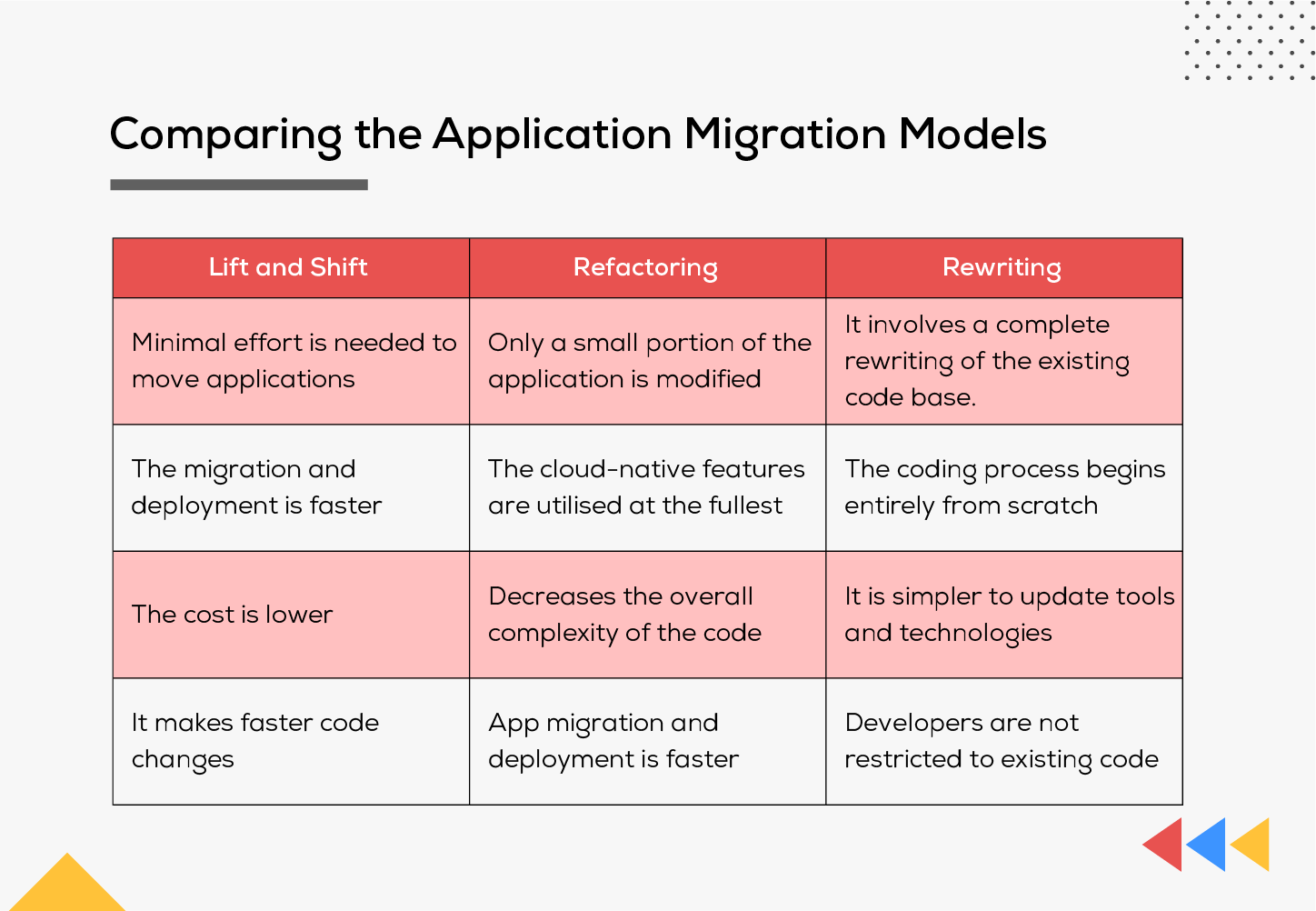
Making the Right Choice - Conclusion
Businesses must carefully choose the optimal migration strategy when relocating their entire application workloads to the cloud. Several factors should be considered while selecting the right options. The factors include budget, time constraints, desired outcome and project scope. Additionally, to determine the most successful strategy for a specific setting, it is necessary to evaluate the infrastructure and applications that are currently in use.
Recommendations for the project may also be made based on the assessment.
The ultimate aim is to find the best method that is within budget and delivered on time. Finally, the appropriate method can be selected through careful consideration, effectively meeting the current business objectives.
Frequently Asked Questions
1. When to use Refactor?
Refactoring is a valuable approach in various scenarios. It can be employed when a business wants to increase the usage of its existing application, enhance agility or ensure business continuity, or when an organization is in the process of implementing service-oriented architecture.
2. What is Monolithic Application?
The monolithic systems are constructed from a single unit. As a result, a single application framework that incorporates services, databases, and load balancers is produced and will function as a single entity.
3. What are the 4 stages of Modernization Theory?
The 4 stages of modernization theory proposed by W.W.Rostow are take-off, maturation, mass consumption and mass production.
4. What is a Legacy Application?
A legacy application is software that is outdated or improperly designed to the point where it is unstable, prone to failure, exposes security flaws and is difficult to maintain and update.
5. When to Rewrite an application?
Here are several reasons to consider rewriting an application: when there is a substantial amount of technical debt, then fixing it is a costly process; when the latest features no longer align with the current framework; or when the existing features of the application have become outdated.
6. What is Legacy Application Modernization?
The process of rebuilding or modernizing an outdated application that is that is still actively used by the business, to ensure its smooth operation in current runtime environments along with other applications is called "Legacy Application Modernization".


